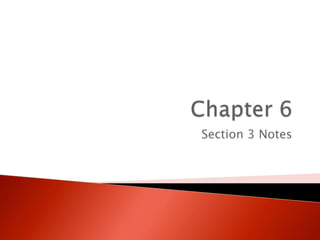
WH Chapter 6 Section 3 Notes
- 2. The Romans regarded Greek art, literature, philosophy, and scientific genius as the height of cultural achievement The Romans adapted Greek and Hellenistic achievements The blending of Greek, Hellenistic, and Roman traditions produced what is known as Greco-Roman civilization Trade and travel during the Pax Romana helped spread this vital new civilization
- 3. In the field of literature, the Romans owed a great debt to the Greeks Many Romans spoke Greek and imitated Greek styles in prose and poetry However, the greatest Roman writers used Latin to create their own literature
- 4. In his epic poem the Aeneid, Virgil tried to show that Rome’s past was as heroic as that of Greece He linked his epic to Homer’s work by telling how Aeneas escaped from Troy to found Rome Virgil wrote the Aeneid soon after Augustus came to power in hopes that it would arouse patriotism and help unite Rome after years of civil wars
- 6. Other poets used verse to satirize Roman society Satirize---to make fun of The poet Martial wrote poems so harsh that he had to use fictitious names to protect himself from retribution
- 7. Roman historians pursued their own theme— the rise and fall of Roman power The historian Livy sought to rouse patriotic feeling and restore traditional Roman virtues by recalling images of Rome’s historic past— he recounted tales of great heroes such as Horatius and Cincinnatus The historian Tacitus wrote bitterly about Augustus and his successors because he felt they had destroyed Roman liberty
- 10. Romans borrowed much of their philosophy from the Greeks The Hellenistic philosophy of Stoicism impressed Roman thinkers Stoics stressed the importance of duty and acceptance of one’s fate They also showed concern for the well-being of all people, an idea that would be reflected in Christian teachings
- 11. To a large degree, Roman art and architecture were based on Greek and Etruscan models However, as with their literature, the Romans made adaptations to develop their own style
- 12. Like the Greeks before them, Roman sculptors stressed realism, portraying their subjects with every wart and vein in place The Romans also broke new ground, by revealing an individual’s character A statue of a soldier, a writer, or an emperor might capture an expression of smugness, discontent, or haughty pride
- 13. Some Roman sculpture was more idealistic For example, sculptors transformed Augustus, who was neither handsome nor imposing, into a symbol of power and leadership Romans beautified their homes with works of art Examples of these works were preserved in Pompeii, a city buried by the volcanic eruption of Mount Vesuvius in 79 AD Artists depicted scenes from Roman literature and daily life into splendid frescoes and mosaics Mosaic---picture made from chips of colored stone or glass
- 14. Please turn to page 139 in our book to learn more about Mount Vesuvius and Pompeii
- 24. While the Greeks aimed for simple elegance in architecture, the Romans emphasized grandeur Immense palaces, temples, and stadiums stood as mighty monuments to Roman power and dignity The Romans improved on devices such as the column and the arch Using concrete as a building material, they developed the rounded dome to roof large spaces The most famous domed structure is the Pantheon, a temple to all the Roman gods, which still stands in Rome
- 26. The Romans excelled in engineering---Roman engineers built roads, bridges, and harbors throughout the empire Romans roads were so solidly built that many of them were still used long after the fall of the empire Roman engineers also built aqueducts to bring water from the hills into Roman cities The wealthy had water piped in, and almost every city boasted public baths were people gathered to wash themselves and hear the latest news and gossip
- 31. The Romans generally left scientific research to the Greeks In Alexandria, Egypt, Hellenistic scientists exchanged ideas freely It was there that astronomer-mathematician Ptolemy proposed his theory that the Earth was the center of the universe, a mistaken idea that was accepted in the western world for nearly 1,500 years
- 33. Although the Romans did little original research, they did put science to practical use The applied geography to make maps and medical knowledge to help doctors improve public health Pliny the Elder, a Roman scientist, compiled volumes on geography, zoology, botany, and other topics---all based on other people’s works
- 35. Probably the greatest legacy of Rome was its commitment to the rule of law and to justice During the Roman empire, the rule of law fostered unity and stability Many centuries later, the principles of Roman law would become the basis for legal systems in Europe and Latin America
- 36. During the republic, Rome developed a system of law, known as the civil law, that applied to its citizens As Rome expanded, it ruled many foreigners who were not covered under the civil law Gradually, a second system of law, known as the law of nations, emerged It applied to all people under Roman rule, citizens and noncitizens Later, when Rome extended citizenship across the empire, civil law and the law of nations were merged together
- 37. As Roman law developed, certain basic principles evolved Many of these principles are familiar to Americans today Examples---an accused person is presumed innocent until proven guilty, an accused person is allowed to face his/her accuser, an accused person can offer a defense against a charge, guilt must be established “clearer than daylight” through evidence, and judges are allowed to interpret the laws and make fair decisions